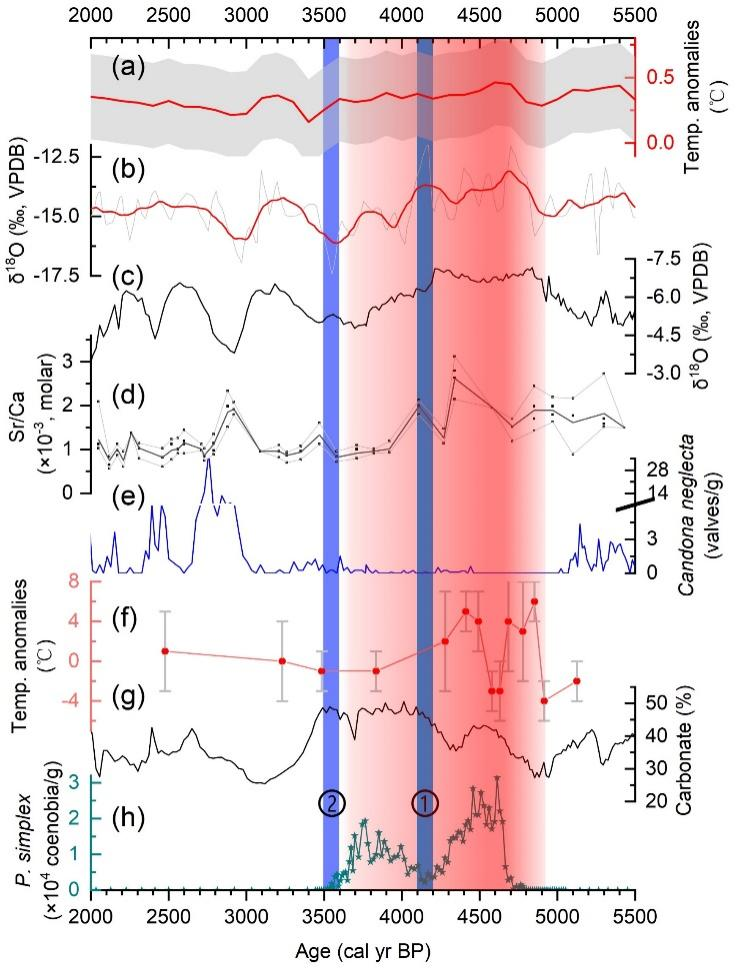Temperature has an important influence on geography, and the results of studies of Holocene temperature change are confusing and urgently need to be studied in depth. Pediastrum are widely distributed and easily distinguishable in freshwater lakes, and their homogeneous habitat requirements, large interspecific variability and short life cycle allow them to respond rapidly to environmental changes in the water environment, making them potential proxies for paleoclimate and environmental change, but there is relatively little research on it.
In conjunction with the results of a large-scale spatial range survey of extant species and varieties of pediastrum in 43 water bodies (lakes and reservoirs) in China and western Mongolia, published earlier this year in the Review of Palaeobotany and Palynology, the group found that mean annual temperature is the most important environmental variable influencing the species composition and spatial distribution of modern pediastrum. The present study also investigated a large body of literature and found the distribution of pediastrum, identifying thatP. simplex is a thermophilic species, P. duplex is a sub-thermophilic species and P. boryanum is an eurythermal species.
Lake Bosten is the largest inland freshwater lake in China and is exceptionally sensitive to regional climate and environmental changes, with a large amount of climate and environmental information preserved in its sediments. Using the changes in the BST04H/BST19B Pediastrum assemblage from the sediment cores of Bosten Lake in 2004 and 2019, combined with the absolute temperature changes reconstructed from the isotope Δ47 of authigenic carbonate clusters in the same borehole, the group reconstructed for the first time the regional middle-late Holocene temperature fluctuations based on the thermophilic species of P. simplex and found that the climate was unusually warm at ~4.7-4.3 ka and the decrease or disappearance of P. simplex during 4.2-4.1 ka and 3.6-3.5 ka is indicative of a cooling climate. This reconstruction is supported by the temperature changes reconstructed from isotope Δ47 of authigenic carbonate clusters in the same borehole and other palaeoclimatic records from the Tibetan and Loess Plateau (Fig. 1). Combined with archaeological data, it was found that the warm climate promoted prehistoric human activity in and around the relatively cold Altai Mountains; extreme cooling events may have triggered the southward migration of prehistoric populations in the Altai Mountains, which led to the emergence of early civilizations in the oases of the North and South Xinjiang basins (Fig. 2). It was also found that a series of cultural changes on the Loess Plateau and the Tibetan Plateau in the northern monsoonal margins of China may have been related to temperature changes in the Middle and Late Holocene, such that the warm climate provided the climatic conditions for the heyday of the Neolithic culture in China and the emergence of the Zonri culture on the Tibetan Plateau, while cold climatic events forced southward migrations, technological updates, and shifts in livelihood patterns, initiating the Bronze Age in China and facilitating cultural exchanges between the east and west.
This study investigates the distribution and climatic significance of Pediastrum species and decodes the sedimentary record of Pediastrum from Lake Bosten, which is important for the future application of Pediastrum as a palaeoecological indicator. The discovery of climate change in the Middle and Late Holocene and its relationship with the evolution of civilisation provides important evidence for environmental archaeology and palaeoclimate studies. The results of this study were published online in volume 265 of Quaternary Science Reviews, a quaternary science journal, in June this year.
The results were mainly funded by the National Natural Science Foundation of China under the major project topic "Historical Background of the Anthropocene" (41991251), the Joint Research Project of Strategic Pioneer Science and Technology Special Project A of the Chinese Academy of Sciences (XDA20090000), the National Key Research and Development Program of China (2017YFA0603403) and the National Natural Science Foundation of China under the surface project (41977390). The work was completed under the supervision of Academician Chen Fahu, and part of the research started 17 years ago with Professor Huang Xiaozhong from the School of Resources and Environment, Lanzhou University as the first and corresponding author, Associate Professor Lei Guoliang from Fujian Normal University as co-corresponding author, PhD students Xiang Lixiong and Huang Chong redentifying the detailed type of Pediastrum, Michael Storozum from Fudan University and Dr. Chuluunbat Munkhbayar from Kobdo University, Mongolia, Associate Professor Otgonbayar Demberel, and Dr. Xuemei Chen from the Northwest Institute of Ecology, Environment and Resources, Chinese Academy of Sciences, Professor Zhang Jiawu from Lanzhou University, Professor Jianhui Chen and postgraduate students Menghan Qiu, Jun Zhang and Mingjie Sun participated in some of the work.
It is reported that Professor Huang Xiaozhong's group has published papers in GRL, LDD, QSR, JHE, RPP and other journals this year on the historical background of the anthropocene and the evolution of human-earth relations, among which the geological evidence and driving mechanism of the agricultural-pastoral conversion in the northern region during the historical period published in LDD has been selected as the cover article.
Links to related results.
[1]https://www.sciencedirect.com/science/article/pii/S0277379121002614
[2]https://www.sciencedirect.com/science/article/pii/S0034666721000208
[3]https://agupubs.onlinelibrary.wiley.com/doi/10.1029/2020GL092288
[4]https://onlinelibrary.wiley.com/doi/10.1002/ldr.4007
[5]https://linkinghub.elsevier.com/retrieve/pii/S0047248420302098

Fig 1. Comparison of climatic records and the stratigraphic record of P.simplex.

Fig 2. The impact of mid to late Holocene temperature change on the spatial and temporal distribution of prehistoric site sites and their 14C chronological points in northwest China.